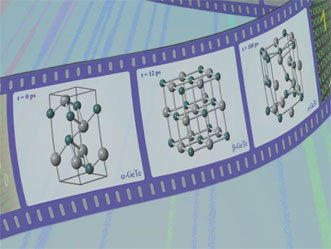Phase-change materials used in DVDs and other digital storage media pass through a previously unknown intermediate atomic state under laser pulses.
The discovery could lead to faster computer memory systems with larger storage capacity — but may also point to an unavoidable limit to data recording speeds, according to researchers at the California Institute of Technology.
The atomic structure of phase-change materials changes from an ordered crystalline arrangement to a more disordered, or amorphous, configuration when illuminated with laser pulses. These two states represent the ones and zeroes of digital data.

Ultrafast electron crystallography allows researchers to "film" the atomic mechanism behind the laser recording process in phase-change materials. Courtesy of Jianbo Hu, Giovanni M. Vanacore and Ahmed H. Zewail.
The speed with which data can be recorded is determined both by the laser's pulse width and by how quickly the material can shift from one state to the other.
With a nanosecond laser, "the fastest you can record information is one information unit, one 0 or 1, every nanosecond," said postdoctoral scholar Jianbo Hu. "To go even faster, people have started to use femtosecond lasers, which can potentially record one unit every one millionth of a billionth of a second. We wanted to know what actually happens to the material at this speed and if there is a limit to how fast you can go from one structural phase to another."
To study this, the researchers developed ultrafast electron crystallography (UEC), which allowed them to observe directly the transitioning atomic configuration of a prototypical phase-change material, germanium telluride (GeTe), under femtosecond laser pulses.
The technique directs a pulse of electrons at the material after each laser pulse to create pictures of the sample's atomic configuration over time.
The technique revealed a previously unknown intermediate phase that appears during the transition from the crystalline to the amorphous configuration. Specifically, the GeTe changes in about 12 ps from a rhombohedral to a cubic structure through a nonthermal process. Then, after hundreds of picoseconds, equilibrium heating causes the material to become amorphous.
Because moving through the intermediate phase takes additional time, the researchers believe it represents a physical limit to how quickly the overall transition can occur — and to how fast data can be recorded, regardless of the laser speeds used.
"Even if there is a laser faster than a femtosecond laser, there will be a limit as to how fast this transition can occur and information can be recorded, just because of the physics of these phase-change materials," said postdoctoral scholar Giovanni Vanacore. "It's something that cannot be solved technologically — it's fundamental."
Despite revealing this limit, the research could one day aid the development of better data storage for computers, the researchers said.
Next the researchers plan to use UEC to study the transition of amorphous GeTe back into the crystalline phase — comparable to the phenomenon that occurs when a rewritable DVD is erased.
The research was published in ACS Nano (doi: 10.1021/acsnano.5b01965).
For more information, visit www.caltech.edu.